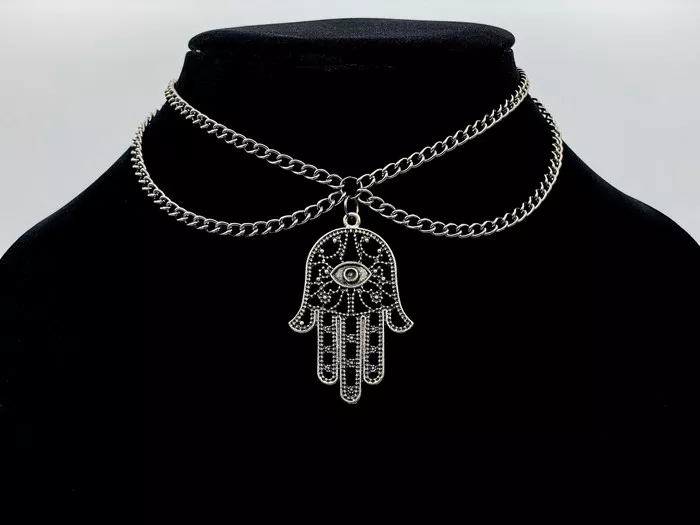Hand pendants have been cherished throughout history, not only for their aesthetic appeal but also for their deep symbolic meanings. These pendants, often found in various forms across different cultures, are imbued with layers of significance that go beyond mere decoration. From protective amulets to symbols of power and faith, hand pendants hold a unique place in the world of jewelry.
The Hamsa: A Universal Symbol of Protection
One of the most well-known hand pendants is the Hamsa, also known as the Hand of Fatima or the Hand of Miriam. This ancient symbol, which depicts an open right hand, has been revered in multiple cultures, particularly in the Middle East and North Africa.
Origins and Historical Context
The Hamsa’s origins are shrouded in mystery, but it is widely believed to have originated in ancient Mesopotamia (modern-day Iraq) around 4,000 years ago. It later spread to various cultures, including Jewish, Islamic, and Christian communities, each adopting and adapting the symbol according to their beliefs and traditions.
Symbolism and Meaning
The Hamsa is primarily seen as a protective symbol, often used to ward off the evil eye – a malevolent glare believed to cause harm. The word “Hamsa” itself means “five” in Arabic, referring to the five fingers of the hand. In Jewish tradition, it is called the Hand of Miriam, named after Moses’ sister, and symbolizes the five books of the Torah. In Islamic culture, it is known as the Hand of Fatima, named after the Prophet Muhammad’s daughter, and represents faith, prayer, fasting, charity, and pilgrimage.
Design and Variations
The design of the Hamsa can vary, but it typically features an open hand with an eye in the center. This eye is a potent symbol of protection against evil. Some Hamsas include additional symbols such as fish, stars, or Hebrew letters, each adding another layer of meaning. The Hamsa can be oriented with the fingers pointing up or down, with each orientation believed to offer different types of protection and blessings.
The Mano Cornuto: A Symbol of Protection and Power
Another significant hand pendant is the Mano Cornuto, or the Horned Hand, which has roots in ancient Europe and is particularly prevalent in Italian culture. This gesture, made by extending the index and little fingers while holding the middle and ring fingers down with the thumb, is used as a protective amulet.
Historical Significance
The Mano Cornuto has been used for centuries as a talisman to ward off the evil eye and other forms of malevolent influence. It is particularly popular in Italy, where it is known as the “corna.” The symbol’s origins can be traced back to ancient Rome, where it was associated with the god of fertility and agriculture.
Cultural Interpretations
In Italian folklore, the Mano Cornuto is often worn or displayed to protect against envy and ill wishes. It is also seen as a symbol of strength and virility. While its primary use is protective, it has also been adopted by various subcultures, including heavy metal music fans, as a sign of rebellion and power.
Hand of Power: A Symbol of Authority
The Hand of Power, or the “Figa” hand, is another prominent hand pendant with deep cultural roots. This symbol, which depicts a closed fist with the thumb sticking out between the index and middle fingers, has been used across various cultures to convey strength and protection.
Historical Context
The Hand of Power has been used as a protective amulet since ancient times. In Roman culture, it was known as the “mano fico” and was believed to protect against the evil eye. The gesture itself is thought to mimic a fig, a fruit associated with fertility and female genitalia, symbolizing life and protection.
See Also: Can You Shower with Ruby Necklaces?
Modern Interpretations
Today, the Hand of Power is still worn as a protective amulet, particularly in South American and Mediterranean cultures. It is often given to children and pregnant women to safeguard them from harm. The symbol has also been incorporated into modern fashion and jewelry, where it is appreciated for both its aesthetic appeal and its protective qualities.
Hand Pendants in Contemporary Culture
In contemporary culture, hand pendants have transcended their traditional meanings and have become fashionable accessories. However, many people still wear them for their symbolic significance. Hand pendants can be found in various styles, from traditional designs to modern interpretations, catering to diverse tastes and preferences.
Fashion and Personal Expression
In the fashion world, hand pendants are appreciated for their unique designs and the stories they tell. They are often worn as statement pieces, adding a touch of intrigue and cultural heritage to any outfit. Many designers incorporate hand symbols into their collections, creating pieces that blend tradition with contemporary aesthetics.
Spiritual and Personal Significance
For many, hand pendants are more than just accessories; they hold personal and spiritual significance. Wearing a hand pendant can be a way to connect with one’s cultural heritage, seek protection, or express personal beliefs. Whether used as a protective amulet or a symbol of faith, hand pendants continue to hold a special place in people’s hearts.
Conclusion
Hand pendants are powerful symbols that have transcended time and culture. From the Hamsa’s protective eye to the Mano Cornuto’s defiance of evil, these symbols carry deep meanings and historical significance. In contemporary culture, they continue to be cherished for both their aesthetic appeal and their symbolic power. Whether worn for protection, personal expression, or cultural connection, hand pendants remain a timeless and meaningful adornment.
Understanding the rich history and diverse meanings behind hand pendants allows us to appreciate these symbols on a deeper level. They are more than just pieces of jewelry; they are embodiments of ancient beliefs, protective talismans, and expressions of personal identity. In a world where fashion and symbolism often intersect, hand pendants stand out as enduring icons of protection and power.

